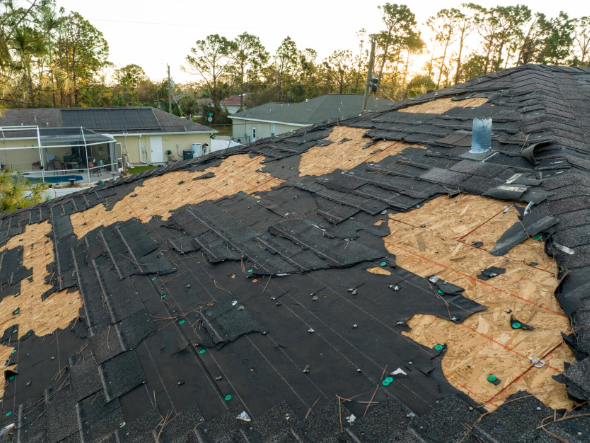
Storms can wreak havoc on your home, leaving behind damage that isn't always immediately visible. While the obvious signs like fallen trees or broken windows grab your attention, hidden damage can quietly escalate into significant problems if left unaddressed. Knowing how to identify and address these issues promptly can save you time, money, and stress.
If you're unsure about the extent of the damage or need expert advice, reaching out to a roofing contractor near me can help ensure your home is thoroughly inspected and repaired as needed.
Key Areas to Inspect for Hidden Storm Damage
After a storm, take a systematic approach to inspecting your home. Focus on areas that are prone to hidden damage and use the following checklist to guide your evaluation.
1. Roof
Your roof is one of the most vulnerable parts of your home during a storm. While missing or damaged shingles may be visible from the ground, other issues like leaks or structural weaknesses may require a closer look.
Signs to Watch For:
Missing, cracked, or curling shingles
Granules from shingles collecting in gutters
Water stains on ceilings or in the attic
Dents or cracks on metal components like flashing or vents
Performing a visual inspection from the ground is a good start, but a professional inspection is often necessary to uncover deeper issues.
2. Gutters and Downspouts
Storm debris can clog your gutters and downspouts, leading to improper water drainage. Over time, this can cause water to pool on your roof or near your foundation, leading to leaks and structural damage.
What to Check:
Blockages caused by leaves, branches, or dirt
Gutters that have pulled away from the roofline
Cracks, dents, or sagging sections
Clearing gutters promptly and ensuring they direct water away from your home will prevent further problems.
3. Siding and Windows
High winds and flying debris can damage siding and windows, even if they appear intact at first glance. Inspect these areas closely for less obvious issues.
Key Indicators:
Dents, cracks, or holes in siding
Loose or missing pieces of siding
Cracked, chipped, or shattered glass
Gaps in caulking or weatherstripping
Damaged siding or windows can lead to drafts, water intrusion, and higher energy bills, so it’s important to address these issues quickly.
4. Foundation
Heavy rain and flooding during storms can cause water to seep into your home’s foundation. Over time, this can lead to cracks, mold growth, or even structural instability.
Signs of Foundation Damage:
Puddles or damp spots near your home’s base
Cracks in walls, floors, or the foundation itself
Doors or windows that stick or no longer close properly
Addressing foundation issues early is crucial to maintaining your home’s structural integrity.
5. Trees and Landscaping
Fallen trees and branches can cause visible damage, but even standing trees can pose risks if they’re weakened by a storm.
What to Look For:
Leaning or uprooted trees
Broken branches hanging over your roof or driveway
Exposed tree roots, which indicate instability
Professional tree care can help prevent further damage and ensure safety.
Steps to Take After Identifying Storm Damage
Once you’ve assessed the storm’s impact, take these steps to mitigate damage and protect your home:
Document the Damage
Take clear photos and videos of all affected areas, including close-ups and wide shots. This documentation is essential for filing insurance claims and assessing repair needs.
Secure Temporary Fixes
If you find exposed areas or leaks, apply temporary fixes to prevent further damage. For example:
Use a tarp to cover roof damage.
Seal broken windows with plastic sheeting.
Clear debris from gutters to restore drainage.
Contact Your Insurance Provider
Report the damage to your insurance company as soon as possible. Provide them with your documentation and follow their guidance on the next steps.
Hire Professionals for Repairs
While some minor issues can be addressed with DIY fixes, most storm damage requires professional expertise. Roofing, foundation, and structural repairs are best handled by licensed contractors to ensure long-term safety and durability.
Preventing Future Storm Damage
Taking proactive measures can minimize the impact of future storms on your home. Consider these tips to better protect your property:
Schedule Regular Inspections: Annual inspections by professionals can identify vulnerabilities before they become major issues.
Reinforce Your Roof: Install impact-resistant shingles or metal roofing to withstand severe weather.
Trim Trees Regularly: Keep branches well away from your home to prevent damage during high winds.
Upgrade Windows and Doors: Install storm-resistant windows and secure doors to better protect your home’s interior.
Ensure Proper Drainage: Maintain gutters, downspouts, and landscaping to direct water away from your foundation.

By staying vigilant and investing in preventative maintenance, you can reduce the risk of costly repairs in the future.
Spotting hidden storm damage early is essential to preserving your home’s safety and value. With careful inspection and timely action, you can address issues before they escalate and ensure your home remains a secure haven.




(0) comments
Welcome to the discussion.
Log In
Keep it Clean. Please avoid obscene, vulgar, lewd, racist or sexually-oriented language.
PLEASE TURN OFF YOUR CAPS LOCK.
Don't Threaten. Threats of harming another person will not be tolerated.
Be Truthful. Don't knowingly lie about anyone or anything.
Be Nice. No racism, sexism or any sort of -ism that is degrading to another person.
Be Proactive. Use the 'Report' link on each comment to let us know of abusive posts.
Share with Us. We'd love to hear eyewitness accounts, the history behind an article.